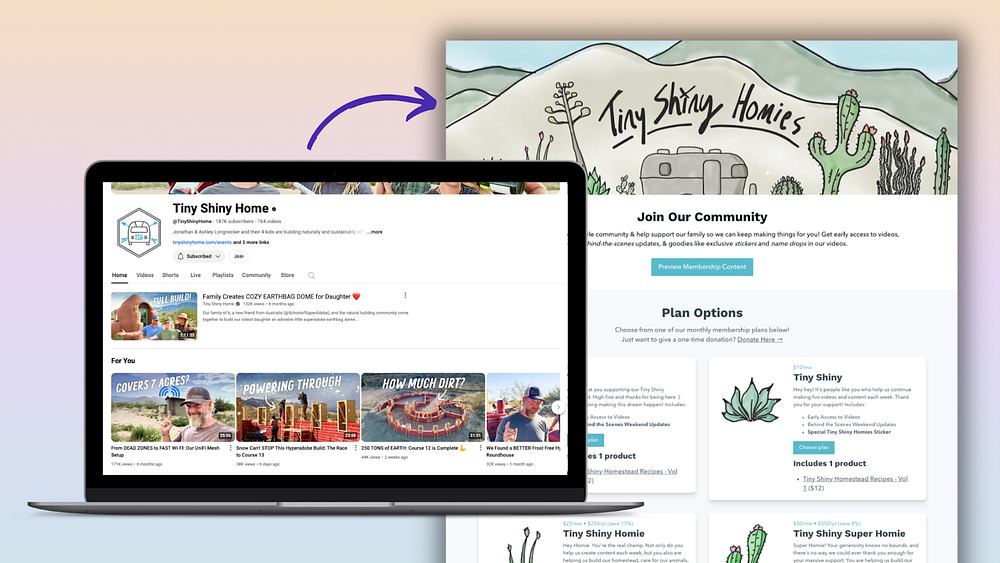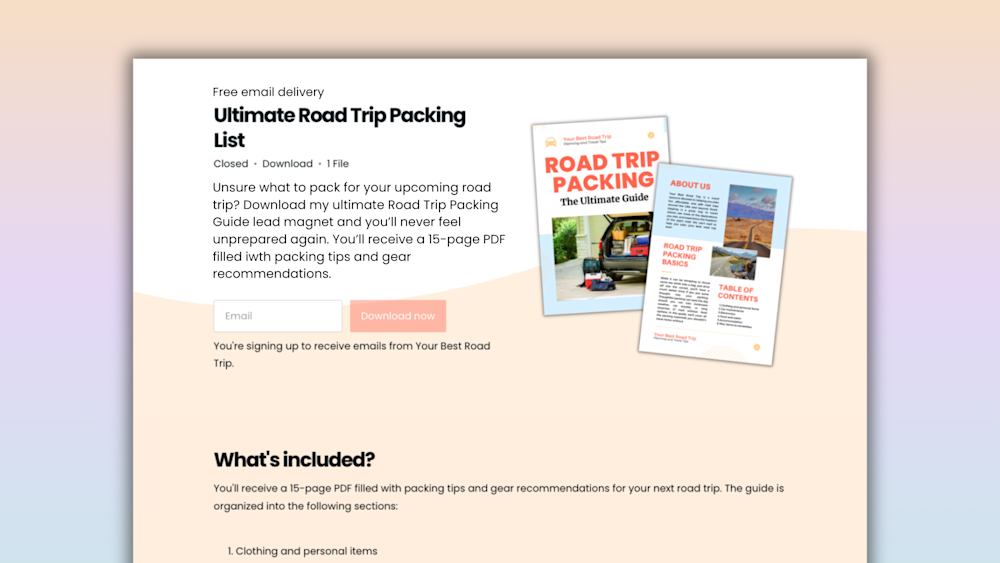Trying to promote your business without a marketing budget is like going on a hike without a map. Sure, you might see some cool landmarks, but you’re more likely to get lost in the woods.
A map shows you the best route to get where you want to go. A marketing budget shows you the best route to reach your business goals.
Whether you’re a new creator or an entrepreneurship wiz, a marketing budget can help you reach new milestones without wasting money.
In this guide, we’ll cover why you need a marketing budget, how much you should spend, and what items it should include.
Here’s everything you need to create a realistic marketing budget for your business.
What is a marketing budget?
A marketing budget is the total amount of money that a business spends to promote its products and services.
Marketing budgets can include paid advertising, software, branding, content creation, social media tools, influencer campaigns, affiliate programs, and more.

Simply put, it’s how much you’ll pay to make sure people know about your awesome courses, digital products, memberships, and webinars.
Marketing is an essential part of running a business, so much so that North American companies spent $249.8 billion on advertising in 2020 alone. Spending on digital ads is increasing every year.

Okay, but do I really need a marketing budget?
Whether you’re brainstorming your first product or selling courses like hotcakes, all creators should have a marketing budget.
By not budgeting, you’re playing a guessing game. Spend too little and you’ll miss out on sales. Spend too much and you’ll end up pouring cash into things that don’t work.
But with a marketing budget plan in place for your business, you’ll know exactly how much you should be spending to get the best return on your investment.
No more aimless wandering through the woods. Now, you’ll have a map.
How to set up your marketing budget
In this section, we’ll take a high-level look at how to set up a marketing budget.
These steps might feel intuitive, but it’s important to have a good understanding of where you’re starting before digging into specific marketing channels later.

1. Identify your marketing goals
The first thing you need to do before you start crunching the numbers? Identify exactly what you want to achieve in your business.
Goals should always be specific, measurable, attainable, realistic, and timely.
Do you want to build brand awareness? Your goal could be to grow your Instagram account by 100 new followers per month.
Do you want prospective customers to join your email list? Your goal might be to create one new lead magnet that results in 20 new email subscribers per week.
By identifying your current business goals, you’ll know what to prioritize as you decide how to allocate your marketing spend.
2. Map out your customer journey
Next, think about the pathway new customers will take from knowing nothing about you to buying from you. This process of turning strangers into loyal fans is called a sales funnel.
It has three phases:
-
Awareness: In this phase, a person has encountered your brand and is aware that you exist. They might not know about your products, but you’re at least on their radar.
-
Consideration: Next, the person becomes interested in what you offer. They are curious about your products and services.
-
Decision: Finally, the person has determined that your products are the right fit for them, and they’re ready to make a purchase.

As you plan how to budget your marketing dollars, think about how you can serve people at each level of your funnel. The next step will help with that.
3. Research your audience
Knowing the age, location, and social media preferences of your audience can help you market to them more effectively.
Start by checking Google Analytics and social media insights to learn basic demographic information about your followers. You can also ask your audience to share this information directly.
-
Use a free survey tool like Survey Monkey to make a questionnaire. Share it with your email list and social media followers.
-
Create a poll on your Facebook page.
-
Use question boxes on Instagram Stories.

Make a note of trends that might come in handy later.
For example, if your survey reveals that none of your followers are on Pinterest, it’s safe to say that paid Pinterest advertising is off the table.
If you find out that 75% of your target audience prefers video over text, you might decide to spend more on video creation.
No audience yet? That’s totally fine! Think about your ideal client or the person you create for.
Brainstorm where they hang out online, what they enjoy, what they dislike, and what kind of pain points they’re experiencing.
You can use this imaginary “target customer” character and supplement it with social media research until you have more robust audience data.
4. Calculate your marketing budget
It’s time to talk numbers.
To determine your small business marketing budget, we’ll begin by looking at your business’s financial situation as a whole.
Think about the total amount of money you’re comfortable spending on your business each month, quarter, or year. Calculate your current revenues and expenses.
There are two ways you can plan your marketing budget.
-
Use a percentage of the total budget you’re able to spend. This is best if you’re a new business.
-
Use a percentage of your business revenue. This is best if you’re already making consistent sales.

A 2021 survey found that the average small business marketing spend is:
-
10 -13% of the total business budget OR
-
5–12% of the total business revenue
Here’s what this looks like in practice.
Percentage of total budget: You’re launching a course, and your total budget for the year is $5000. You choose to spend 13% of your budget on marketing activities, which would give you an annual marketing budget of $650.
Percentage of total revenue: You earn $1500 per month selling an online membership, and you want to devote 10% of revenue to marketing costs. Your marketing budget for the month would be $150.

You might be thinking, “Wait, that’s it?”
Yep! The interesting part of your budget isn’t the exact percentage you choose to allocate, it’s what you spend that allocation on.
Don’t get too bogged down on whether you should use 7% or 8% or 9%. This is just the starting point.
It may seem overly simplistic, but keep this overall number in mind when we move into the next section about what line items to include in your budget plan.
5. Track and adjust your marketing strategy
As you grow in your business, it’s important to track what’s working and what isn’t. A simple spreadsheet works great!
Make a column for each month and a row for each item included in your marketing budget. Then, make a row to track the goals you outlined in step one.
At the end of each month, jot down how much you spent and what progress you made toward your goal. If you’re not moving in the direction you’d hoped, it’s okay to make changes to your budget.
Here’s an example of what it might look like:

Now, let’s figure out what to do with that money specifically.
Marketing budget examples
In this section, we’ll look at some hypothetical marketing plans for businesses of different sizes.
A word of warning though, don’t let shiny-object syndrome wreak havoc on your budget.
A lot of entrepreneurs (myself included) end up overspending on premium tools when free or low-cost options would have been just as effective.
So in talking about ways to spend your marketing budget, we’ll also look at what you really need versus what’s nice to have.
$100/month or less marketing budget example
At this level, free and low-cost marketing tools are your best friend. You can always scale up as you earn more, and there are tons of great options available for entrepreneurs on a shoestring.

Set up your website: Your first priority is creating a simple website. You can use a low-cost platform, and you definitely do not need to hire a designer to build a custom website. If you’re a Podia user, you can use the native website builder to set up your site.
Email marketing: Next, invest in email management software. Free options are fine at first, but eventually, you’ll want to have the segmentation and customization options that come with premium tools. Podia includes email marketing features in all plans.

Basic branding: While it’s important to have a cohesive-looking brand, this doesn’t have to come with a big price tag. Start by creating graphics using free graphic design tools or a low-cost logo generator.
Content creation: Spend the rest of your budget on creating blog posts, lead magnets, and videos.
No need to stop your marketing efforts once you’ve maxed out your budget. These marketing channels won’t cost you anything except for your time:
-
Submit guest blog posts to other websites
-
Apply to be featured on podcasts
-
Do Instagram takeovers with other creators in your niche
-
Pitch news outlets for press releases
-
Post on social media
-
Host a free Facebook Live event
-
Start exploring free SEO tools
$500/month marketing budget example
If you have a $500 per month marketing budget for your small business, you’ll have more wiggle room. In addition to everything above, consider adding these items to your budget.

SEO tool: SEO tools can range from $10 per month to well over $100 per month depending on how much power you need for your business. Even low-cost SEO software provides mountains of information compared to free tools.
Social media scheduling tool: It can be tedious to post on your social media accounts every single day. A scheduling tool allows you to bulk upload pins, tweets, Instagram posts, and Facebook posts in advance.
Experiment with paid advertising: Learning about paid search and social media advertising is a journey. With this budget, you can begin experimenting with some paid promotions. Start small, around $50 — $100 per month, to learn how to set up ads and interpret your results.

Affiliate program: The affiliate management tools included with platforms like Podia are more than enough for most creators. If you need advanced features, you can also purchase a third-party affiliate management system.
Content creation: Spend any remaining funds on more content creation.
$1000/month marketing budget example
If you have $1000 per month to spend on your marketing budget, add the following tools to your marketing stack in addition to everything mentioned above.

Paid advertisements: At this stage, you can run larger paid search engine and social media campaigns. Expect to spend a few hundred dollars per month to make it worth the investment.
Webinar software: Level up your sales funnel with webinars. Choose a webinar platform or a tool with webinar features like Podia, then it’s lights, camera, action.

Update branding: Consider doing a branding and logo refresh with a designer. Hire a professional to make website updates if needed. You can also commission product mockups and graphics to use throughout your brand.
Continue to update scheduling, email, and SEO tools: Do an internal audit to see if any of your tools need upgrading. As your business grows, you might need more advanced packages.
That covers our budget models, but if you’re still scratching your head about what all of it means, we’ll wrap up by going over each section and why it is (or isn’t) worth investing in.
How to spend your marketing budget
The moment you’ve been waiting for — you get to decide what specific marketing tactics should be included in your budget.
Below, we’ll take a look at some of the main types of digital marketing you can use in your business. These are categories that you might use as line items in your marketing budget.
Branding
Having cohesive branding makes your business look more professional. Branding can include logos, fonts, color pallets, social media templates, images, and other visual content.
Simple logo designs start around $100, and custom brand kits can run around $3000.
Big companies may invest thousands of dollars into branding, but this doesn’t have to be a huge part of your marketing budget when you’re a new business.
In the beginning, skip the designer and use a low-cost logo maker website. If you’ve got an eye for design, you can make your own using free tools like Canva.

Down the road, you can always invest in more customized images, graphics, logos, and templates as your brand grows.
Website
Having a website is an important asset since this is where your business lives on the internet.
Custom-built websites can cost thousands, but there are also affordable options that won’t cost a fortune. Squarespace, Wix, Weebly, and WordPress all offer beautiful templates that range from free to around $100.

Basic website hosting costs around $5 — $10 per month, and your domain should set you back about $20 per year.
You can also choose to use an all-in-one platform that includes product creation tools and a website builder.
Customizable websites are available with Podia, for example, so you don’t have to worry about setting up a website from scratch.

Email marketing
Email marketing is considered to be one of the most effective marketing techniques in the game.
A CampaignMonitor study found that the average return on investment for email marketing was $44 for every $1 spent.

For context, that’s about 40x more effective than popular social media platforms Facebook and Twitter.
Email marketing tools allow you to send notifications, segment your audience, and schedule an automated email series for new subscribers.
Premium email marketing platforms typically range from $10 — $100 per month and will get more expensive as you gain subscribers.
Written content marketing
Written content for your blog or website is a powerful tool for marketing your small business.
Having a blog gives you more opportunities to be discovered through organic search, and the numbers don’t lie — 70% of marketers invested in content in 2020.
One study found that creators with blogs got 68% more leads than creators who didn’t have blogs.

Why?
Imagine that you sell a course about baking.
On your website, you write a blog post about your best baking tips. Within your post, you naturally mention your baking course and include a CTA (or call to action) encouraging readers to click on your course sales page.
You also have a free mini cookbook that people get when they subscribe to your email list. In that blog post, there’s a place where readers can join to get the freebie.
If that post ranked in Google, went viral on Facebook, or performed well on Pinterest, tons of new readers would visit your site and enter the “Awareness” stage of your sales funnel.
On social media, posts get buried by algorithms and cute puppy videos. On your blog, written content lasts forever.
You can choose to write the content yourself or outsource content creation to a freelance writer or content creation agency.
The rate that freelancers charge can vary drastically, but it’s usually less expensive than hiring an agency.
Video content
As with written content, video marketing is a way your business can be discovered organically on the web.
According to a 2021 study, 78% of video marketers said that using video helped increase sales. 84% of those surveyed said that watching a brand’s video convinced them to make a purchase.

Uploading videos to YouTube is free, and you can create them yourself, use a video creation tool, or hire a company to make them for you.
SEO
SEO, or search engine optimization, means optimizing your website, written content, and videos to show up higher in search engines.
SEO tools allow you to research keywords, analyze your competitors, and track your rankings.
There are free SEO tools like Google Search Console and Google Keyword Planner. Keysearch and Ubersuggest are low-cost options that cost anywhere from $10 — $50 per month.
Pricier options like SEMRush and Ahrefs offer more advanced features. These start around $100-$120 per month.
You can also hire SEO companies to manage this for you, but this is one skill I’d recommend learning for yourself before hiring a third party.
SEO is a long-term strategy that can be extremely expensive when outsourced and extremely inexpensive when handled in-house, so it’s worth spending some time to learn how it works.
Social media marketing
Social media marketing means promoting your business on social platforms like Instagram, Facebook, Twitter, LinkedIn, and Pinterest.

Hootsuite has broken social media marketing down into a few simple components. To succeed on social, you should invest in:
-
Content creation, like photos, videos, graphics, and writing
-
Social media scheduling tools so that posting doesn’t take up your whole day. (85% of marketers in a 2019 study said they used a third-party social media scheduling tool.)
-
Paid social media marketing campaigns, where you pay to have your posts reach more people
-
Paid influencer campaigns, where a creator with a large audience promotes your product in exchange for payment
-
Training for yourself or your marketing team to learn about social media trends
-
Outsourcing or hiring a dedicated social media manager
You can use your audience survey from earlier to determine the best social media platform for your business.
Paid advertisements
Using paid advertisements means that you spend money to have your business show up in search engine results. The more you spend, the more people will see your advertisement.
A common type of paid advertisement is called pay-per-click, or PPC. In a PPC structure, you choose a keyword, and your ad will show up in the search results for that phrase. You’ll pay a set price when a user clicks on the ad.
Google estimates that businesses earn $2 in revenue for every $1 they spend on ads.

While these types of advertisements can be very effective, there’s a steep learning curve.
The big downside is that you have to keep paying for them. If you stop funneling money into your campaign, your traffic will stop.
Webinars
Webinars (or web seminars) are video presentations or workshops that are run online.
In a webinar, you can share your expertise and interact with your audience in real-time, offering a more personalized experience.
These days, making a connection is key. 53% of marketers say that webinars generate the most high-quality leads, and 90% of webinar marketers report that their webinars were successful.

To run a webinar, many people use specialized webinar software. These tools typically start at about $30 per month and increase in price the more participants and features you need.
Webinar integration is included in all Podia plans.
Affiliate marketing
Affiliate marketing is when someone else promotes your course, product, or service in exchange for a commission on each sale they generate.
Let’s say you have an affiliate program for your $100 course, and the affiliate commission is set at 25%.
An affiliate promotes your course to their audience, and someone buys it through their link. That means you get $75, and they get $25. Easy, right?
Affiliate marketing can be a gold mine since you don’t have to pay affiliates anything unless they generate sales for you.
Plus, having more people promoting your product to the world builds social trust and gets you in front of fresh eyes.
Managing your affiliate program can have additional costs if you use third-party software.
An advanced affiliate management system can cost several hundred dollars per year, but this tool is included with some creator platforms like Podia.

But seeing is believing, right? Explore Podia's all-in-one creator features for yourself — sign up for a free 30-day trial today.
We hope to see you there!
Now you have an airtight marketing budget
A marketing budget is essential to promoting your awesome products and services to the world. With more people seeing what you offer, you can serve more customers and earn more income. A true win-win!
To make a marketing budget, you need to:
-
Research your audience
-
Plot your customer journey
-
Determine your big-picture marketing spend
-
Choose exactly what to spend your marketing budget on
-
Track your results and adjust as needed
Gone are the days of guessing how much money to spend on your marketing budget! With a bit of research and a thoughtful game plan, you’ll be on your way to more leads, higher sales, and droves of happy customers.



